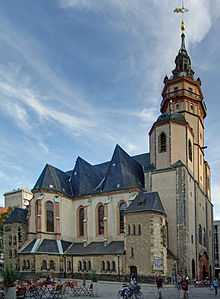Preise, Jerusalem, den Herrn, BWV 119

Preise, Jerusalem, den Herrn (Praise the Lord, o Jerusalem), BWV 119, is a sacred cantata by Johann Sebastian Bach. He composed it in Leipzig for Ratswechsel, the inauguration of a new town council, and first performed it on 30 August 1723.
History and words
Bach composed the cantata during his first year in Leipzig for a service at St Nicholas Church to celebrate the change of council or Ratswechsel.[1] Early in his career he had written at least one cantata for the equivalent service at Mühlhausen. There are five surviving cantatas for the Ratswechsel at Leipzig.
The text of the cantata consists of verses from psalms 147, 85 and 126, lines from Martin Luther's German Te Deum "Herr Gott, dich loben wir" and poems by unknown writers. To suit the event for which it was written, these are all turned into hymns of thanking and praising God for Leipzig's prosperity and asking him to protect the city in the future.
Scoring and structure
The cantata is scored for four soloists—soprano, alto, tenor and bass—a four-part choir, four trumpets, timpani, two recorders, three oboes, two oboes da caccia, two violins, viola, and basso continuo.[2]
The work has nine movements:
- Chorus: Preise, Jerusalem, den Herrn
- Recitative (tenor): Gesegnet Land, glückselge Stadt
- Aria (tenor): Wohl dir, du Volk der Linden
- Recitative (bass): So herrlich stehst du, liebe Stadt
- Aria (alto): Die Obrigkeit ist Gottes Gabe
- Recitative (soprano): Nun! wir erkennen es und bringen dir
- Chorus: Der Herr hat Guts an uns getan
- Recitative (alto): Zuletzt! Da du uns, Herr, zu deinem Volk gesetzt
- Chorale: Hilf deinem Volk, Herr Jesu Christ
Music
Even among other festive music written by Bach, this work's scoring for four trumpets is unusual. It is characterised by a very solemn character and the attributes of courtly homage music, such as the opening chorus in the form of a French overture or fanfare-like trumpet interjections in the bass recitative.[3] Bach created a work that in musical terms corresponds less to sacred music and more to the type of secular music for a princely court, as had been required of him during his time in office in Köthen. Only in its final two movements does Bach again use simple forms to emphasize the work's character of a church cantata, implying that earthly powers do not last, but God – the supreme ruler – is entitled to have the last word.[4]
In addition to its dotted rhythms, the opening chorus is remarkable for the musical opposition between the trumpets and the rest of the instrumental parts. The middle section is faster, incorporating both fugal techniques and paired entries. The coda is an adaptation of the first section.[5]
After a secco recitative, the oboes da caccia present the dotted-rhythm ritornello to introduce the tenor aria. The vocal entry is before the ritornello cadence. The following bass recitative is introduced and concluded with a fanfare-like trumpet and timpani line.[5]
The fifth movement is an alto aria with two obbligato recorders, the only minor-mode movement. The obbligato presents high repeated notes beginning midway through the ritornello theme, which recurs as episodes and at the conclusion of the movement.[5] The movement is, in effect, a trio sonata.[6]
A soprano recitative precedes the second chorus, which is introduced by a long ritornello theme featuring an "imperious" trumpet melody. This theme plays four times during the da capo movement, which also includes elements of fugue. A very short yet harmonically adventurous alto recitative serves as the penultimate movement. The cantata ends "with the subtlest touches of flamboyance" in a chorale.[5]
Recordings
- Amsterdam Baroque Orchestra & Choir, Ton Koopman. J.S. Bach: Complete Cantatas Vol. 10. Erato, 1998.
- Bach-Chor (Kurrende der Christuskirche) & Bach-Orchester Mainz, Diethard Hellmann. J.S. Bach: Cantatas BWV 119 & BWV 129. Da Camera, 1967.
- Bach Collegium Japan, Masaaki Suzuki. J.S. Bach: Cantatas Vol. 16. BIS, 1999.
- Gächinger Kantorei / Bach-Collegium Stuttgart, Helmuth Rilling. Die Bach Kantate Vol. 66. Hänssler, 1978.
References
- ↑ "Cantata BWV 119". bach-cantatas. Retrieved 1 June 2013.
- ↑ "BWV 119". University of Alberta. Retrieved 1 June 2013.
- ↑ von Wijnen, Dingeman. "Liner notes for Bach Cantatas, Vol. 10" (PDF). bach-cantatas. Retrieved 1 June 2013.
- ↑ Wolff, Christoph. "Liner notes to Bach Cantatas, Vol. 29" (PDF). bach-cantatas. Retrieved 1 June 2013.
- ↑ 5.0 5.1 5.2 5.3 Mincham, Julian. "Chapter 83 BWV 119". jsbachcantatas. Retrieved 1 June 2013.
- ↑ "Cantata No. 119". Allmusic. Retrieved 1 June 2013.
Sources
The first source is the score.
- Cantatas, BWV 111–120: Scores at the International Music Score Library Project
Several databases provide additional information on each cantata:
- BMV 119 Preise, Jerusalem, den Herrn history, scoring, sources for text and music, translations to various languages, discography, discussion, Bach Cantatas Website
- BWV 119 – "Preise, Jerusalem, den Herrn" English translation, discussion, Emmanuel Music
- Preise, Jerusalem, den Herrn history, scoring, Bach website (German)
- BWV 119 Preise, Jerusalem, den Herrn English translation, University of Vermont
| ||||||||||
|